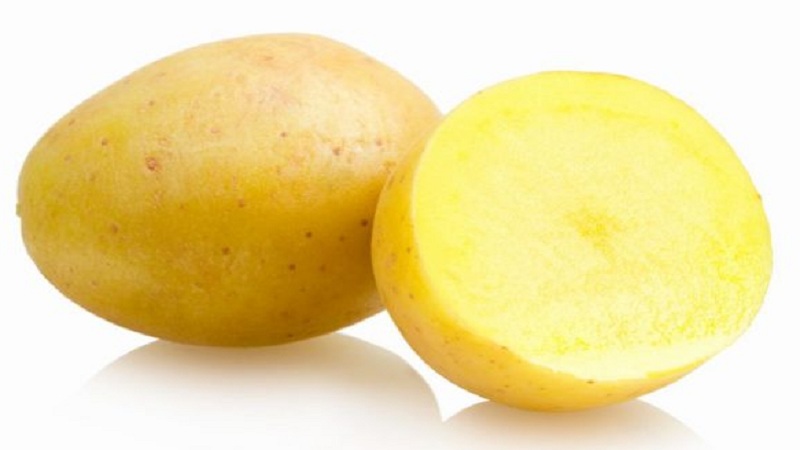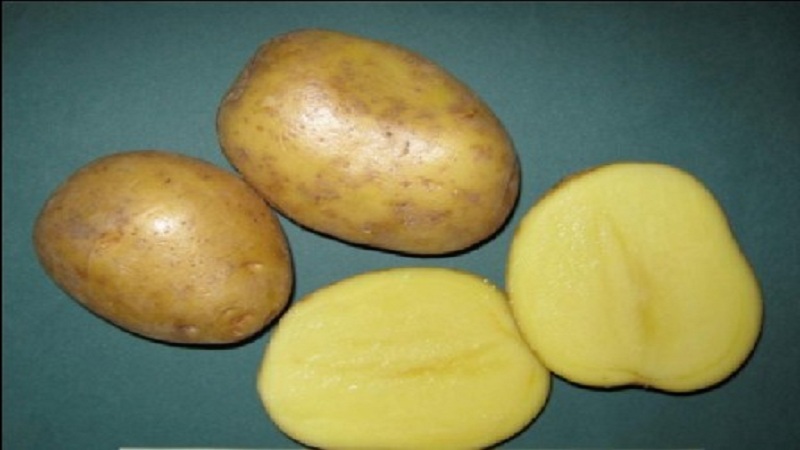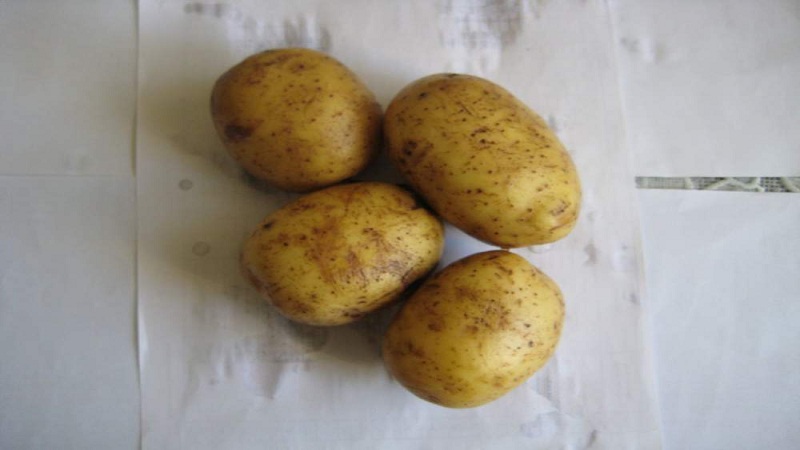An early table potato variety that is not afraid of sudden changes in temperature, "Madeleine"
Dutch Madeleine potatoes are an early high-yielding variety. It adapts well to any climatic conditions and soil type, has a high market value, excellent taste and strong immunity. Yellow flesh with a moderate amount of starch is a storehouse of carotenoids and antioxidants.
In this article, we have collected complete information about Madeleine potatoes with a description of the variety and photos.
The content of the article
Description of the variety and its origin
Madeleine variety (officially Madeline) is a selective product of the Dutch agronomists AGRICO U.A.
Photo: Madeleine potatoes.

The table contains the distinctive characteristics of the Madeline variety.
| Indicators | Characteristic |
| Ripening period | 70-80 days |
| Bush | Medium or tall, intermediate type, semi-upright |
| The number of tubers in the bush | 8-11 |
| Weight | 84-118 g |
| The form | Oval |
| Coloration | Skin and pulp - yellow |
| Leaves | Large, light green, strongly wavy at the edges |
| Corolla color | White |
| Starch content | 11,6-14,7% |
| Taste | Excellent (5 on a five-point scale) |
| Cooking class / group | A / B (weak or medium friable) |
| Yield | Average indicator - 164-232 c / ha, maximum - 327 c / ha |
| Marketability | 80-93% |
| Keeping quality | 91% |
| Appointment | Dining room |
| Sustainability | To cancer, golden potato cyst nematode, late blight of tubers, banded mosaic virus |
| Transportability | High |
Chemical composition
The table shows the complex of vitamins and minerals contained in 100 g of raw tubers.
| Name | Content | Norm |
| Beta carotene | 0.001 mg | 5 mg |
| Vitamin B1 | 0.081 mg | 1.5 mg |
| Vitamin B2 | 0.032 mg | 1.8 mg |
| Vitamin B4 | 12.1 mg | 500 mg |
| Vitamin B5 | 0.295 mg | 5 mg |
| Vitamin B6 | 0.298 mg | 2 mg |
| Vitamin B9 | 15 mcg | 400 mcg |
| Vitamin C | 19.7 mg | 90 mg |
| Vitamin E | 0.01 mg | 15 mg |
| Vitamin K | 2 μg | 120 mcg |
| Vitamin PP | 1,061 mg | 20 mg |
| Potassium | 425 mg | 2500 mg |
| Calcium | 12 mg | 1000 mg |
| Magnesium | 23 mg | 400 mg |
| Sodium | 6 mg | 1300 mg |
| Phosphorus | 57 mg | 800 mg |
| Iron | 0.81 mg | 18 mg |
| Manganese | 0.153 mg | 2 mg |
| Copper | 110 mcg | 1000 mcg |
| Selenium | 0.4 μg | 55 mcg |
| Zinc | 0.3 mg | 12 mg |
Advantages and disadvantages
Among the advantages of the Dutch variety:
- early maturity;
- high productivity;
- resistance of tubers to damage (the wounds heal quickly);
- adaptation to any climate and soil;
- excellent taste;
- resistance to viral and fungal diseases.
There are much fewer disadvantages:
- susceptibility to late blight of the tops;
- the need for preliminary heating of tubers;
- nitrogen level control.
Features of planting and growing
The Madeleine variety does not cause any particular difficulties when growing, but it requires adherence to a number of rules: warming up and vernalization of seeds, landing in dry, warm soil, moderate watering, hilling and minimal application of nitrogen fertilizers.
Preparing for landing
Tubers are germinated and heated before planting. 20 days before the expected date of planting, the seed is taken out of the storehouse into the light, diseased and damaged specimens are discarded, the remnants of the earth are cleaned, washed under running water and soaked in a disinfectant solution for 15-20 minutes.
The best solution is boric acid (10 g of substance per 10 liters of water). You can also take potassium permanganate and Fitosporin-M.
After processing, the tubers are left to dry in the sun, and heated for three days at a temperature of + 25 ° C.
For germination in the light, the tubers are laid out in one layer in wooden or plastic boxes stacked on top of each other. The containers are placed in a bright room, avoiding direct sunlight. The top drawer is covered with a breathable fabric.
Ground requirements
Madeline potatoes grow in any type of soil, but show the best results in loose and nutritious. In autumn, the site is dug up, harrowed, loosened and manure is introduced. In spring, sow oats, lupine, rye, flax, wheat.
After a month, the green manure is mowed and embedded in the soil in order to enrich it with nitrogen and prevent the development of pathogenic microflora.
Timing, scheme and landing rules

Planting time depends on the region. In the south, potatoes are planted at the end of April, in the middle lane - in early May, in the north - in the second decade of May. Optimum conditions for planting tubers: air temperature + 10 ° С, soil temperature - + 4 ... + 7 ° С. Many gardeners plant during the flowering period of dandelions.
The traditional fit is ordinary. With the help of a rope, even rows are measured and holes are dug with a depth of 10 cm. 25-30 cm are left between the holes, 60-70 cm between the rows.
reference... Potato planting rate for industrial cultivation - 45,000 pieces per hectare.
The nuances of care
The culture does not develop well in dry soil, but it does not tolerate an excess of moisture. The best solution to the irrigation issue is to install a drip irrigation system. The first time is watered when the sprouts reach 5-10 cm. Before that, the plant has enough moisture from the tubers. In the future, they are guided by weather conditions. During the rainy period, the supply of moisture is suspended, in drought it is increased to twice every 10 days. The rate of water consumption per bush is 2-3 liters.
The period of green mass gain is rather long. During this time, weeds have time to germinate in the beds, so loosening and weeding are required. Weeding begins one week after disembarkation.
Hilling stimulates the formation of tubers and the growth of green mass. It is carried out 2-3 times per season: after the sprouts stretch 5-10 cm, two weeks after the first and after flowering. The soil must be moist.
Madeline variety does not react well to excess nitrogen, goes into the set of foliage, and the tubers are formed small. Potatoes get all the necessary substances from the soil after planting. Therefore, gardeners pay due attention to the application of fertilizers at the stage of soil preparation.
During this period, make:
- chicken manure solution in a ratio of 1:15;
- 35 g of ammonium nitrate, 20 g of superphosphate, 10 g of potassium salt, 2 g of copper sulfate per 10 liters of water or 30 g of nitrophosphate per 10 liters;
- urea (10 g per 10 l of water) or green fertilizer (nettle infusion with tops) is used as foliar feeding.
Disease and pest control
The Madeline variety is susceptible to late blight of the tops. The disease manifests itself in the form of brown spots on the leaves and white pubescent plaque on the back. If you look closely, you can see phytophthora spores. The plant lags behind in development, the ground part withers and dries.
To prevent infection:
- tubers are treated with disinfecting solutions;
- observe the rules of crop rotation, weeding;
- tubers and tops are removed in a timely manner;
- control the level of moisture and the amount of nitrogen in the soil;
- planting is sprayed with milk whey with iodine (10 drops per 1 liter of fermented milk product);
- fertilized with potassium and phosphorus in a timely manner.
For treatment, drugs are used: "Oksikhom", "Ridomil Gold", "Gamair", "Metaxil", "Bravo", "Planriz", "Alufit".
Plant infusions with a pungent smell help to fight the Colorado potato beetle:
- 300 g of celandine, 200 g of ash per 10 liters of water;
- 2 kg of yellow bitterness, 30 g of soap shavings per 10 liters of water;
- 200 g cloves of garlic or green arrows, 40 g shavings of soap per 10 liters of water;
- 200 g of tobacco shag, 2 kg of green bugs per 10 liters of water.
Spraying is carried out in the evening in dry, calm weather on dry foliage. Ready infusions are used immediately. Only fresh are they highly effective. To prevent the addiction of beetles, the means are alternated.
To scare off pests, marigolds, borago, calendula, coriander, nasturtium, matthiola, hemp, beans, peas, horseradish, onions, tansy, catnip and white lamb are planted next to potato beds.
With the extensive spread of the pest, insecticides are used: "Prestige", "Aktara", "Corado", "Lightning", "Commander".
Collection, storage and use of the crop

Rules for picking early potatoes:
- Digging of Madeline potatoes is carried out twice: in mid-July and at the end of August.
- The tops are removed a week before harvesting. During this time, the skin of the tubers becomes dense, which ensures long-term preservation.
- After harvesting, the tubers are left in a dry, dark place for two weeks to dry and only then are they removed to a cool place. Potatoes intended for planting are left in the sun for 3-4 days for landscaping.
- The harvested crop is sorted, damaged and diseased specimens are discarded.
The cellar and storage containers are washed, disinfected and dried. For storage, use wooden boxes, nets, burlap. The optimum room temperature is + 2 ... + 4 ° С, humidity - 70-80%.
Due to its moderate starch content, Madeline is suitable for frying, cooking, baking, stewing. The pulp does not darken after cutting and cooking.
Features and difficulties of growing
To obtain an environmentally friendly harvest and reduce labor costs for care, gardeners use the method of growing potatoes according to Lyadov. Planting is carried out in closed bed-boxes, which are installed in the direction from north to south.
For their construction, sticks, boards, bricks are used. The height of the side is 20 cm, the width of the box is 1 m. The bottom is lined with straw, grass, hay, dry leaves or paper. Put compost and soil on top.
When planting the beds, you do not need to dig deeply, since there are organic fertilizers at the bottom. The top layer is slightly loosened and holes are dug 10 cm deep, with an interval of 30-40 cm. Planting is carried out in a checkerboard pattern in two rows. Wood ash and ground eggshells are placed on the tubers. The holes are covered with soil.
After the emergence of sprouts 10 cm high, weeds are weeded and the beds are covered with mulch - hay, straw or sawdust.
Tips and Feedback
Farmers' reviews of the Madeline variety are positive. The culture is appreciated for the excellent taste of the tubers, high productivity and ease of care.
Alexander, Kirov: «Madeleine is an excellent productive and early potato variety. In our area it grows well, late blight is rarely affected. The year before last, I faced an invasion of Colorado, which only Aktara helped to get rid of. On the advice of a neighbor in the country, I put onion peels, ash and spoiled onions in each hole. Beetles don't like the smell of decay. "
Galina, Kholmsk: “In the beginning, Madeleine's potatoes were bought at the local market. We liked him so much that we decided to plant him in our country house. The tubers are neat, almost the same size, with a pleasant taste. During cooking, the pulp does not fall apart; after cutting, it does not darken when raw. Stored in the basement until spring, and does not germinate. "
Alexey, Vyatka: “I grow Dutch varieties of potatoes for sale. They are very productive and resistant to most diseases. One of these varieties is Madeline. This is an early potato that can be dug twice. It does not impose special requirements on the soil, but does not like an excess of nitrogen. I feed it with mullein and nitrophobic. "
Read also:
A viable variety of blue potatoes with amazing taste.
Late-ripening variety of "Cardinal" potatoes.
How to breathe correctly over potatoes with sinusitis and is it possible to do it.
Conclusion
The Madeline variety is popular with farmers due to its ability to harvest two crops per season, unpretentious care and high taste. Compliance with the rules of planting and cultivation ensures a stable result.
Pre-planting preparation of tubers provides for warming up and germination, treatment with disinfecting solutions for the prevention of fungal diseases. The culture does not "like" an excess of nitrogen and moisture in the soil, so the main task of gardeners is to control these indicators.